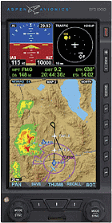Vincent of Plastic Pilot has just posted a story sent to him by a pilot named Jeff who recently experienced a major instrument (Garmin and GPS) failure shortly after take-off that left him GLAD that he had learned how to fly using the old mechanical instruments. The story only further adds to the debate of modern technology (glass cockpits, GPS etc.) verses traditional technology (mechanical gauges etc.) and is a reminder of past stories or advice reported on other blogs.
 One such piece of advice came from Paul of Ask A CFI.com who had recently answered a question from someone contemplating flight training in a airplane equipped with a glass cockpit versus an airplane equipped with traditional gauges by saying that the G1000 can become a hindrance to training because “the training now becomes focused on learning the tool and not obtaining the objective of the actual flight lesson.” Luckily for Jeff, he had learned the basics of flying and was able to quickly compose himself and safely land the airplane.
One such piece of advice came from Paul of Ask A CFI.com who had recently answered a question from someone contemplating flight training in a airplane equipped with a glass cockpit versus an airplane equipped with traditional gauges by saying that the G1000 can become a hindrance to training because “the training now becomes focused on learning the tool and not obtaining the objective of the actual flight lesson.” Luckily for Jeff, he had learned the basics of flying and was able to quickly compose himself and safely land the airplane.
Moreover, although many of the applications for iPhones and other electronic devices reported on this blog are very useful, they are not so useful if the device they are on fails. For example: Jason Schappert of MzeroA.com mentioned a story in one of his blog posts that involved one of his students who brought his approach plates in electronic format for a flight only to have his batteries die during training. The moral of that story is that a pilot should ALWAYS have a printed copy of any chart or publication handy.
Anyway, Jeff’s story and the comments they have generated are well worth reading and serve as a reminder that modern gizmos are not a complete substitute for old-fashion knowhow and technology.
In 100 years the G1000 will be "old-fashion knowhow and technology."
It is always interesting to see someone draw an arbitrary time line and then declare that line as the demarcation of reliability. Anything mechanical breaks, even billion dollar space shuttles.